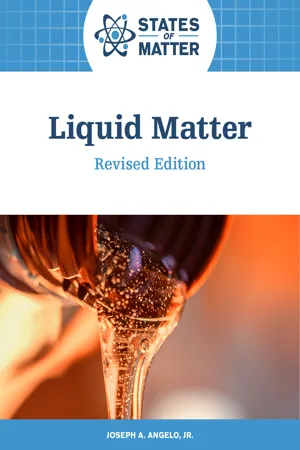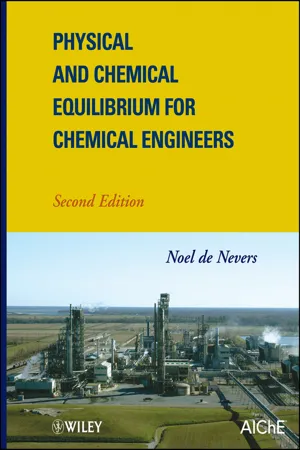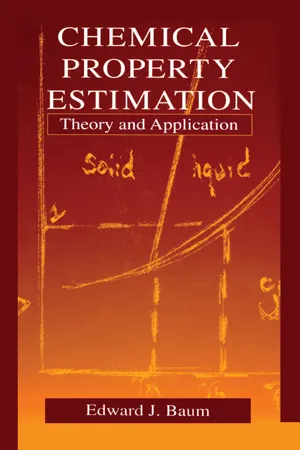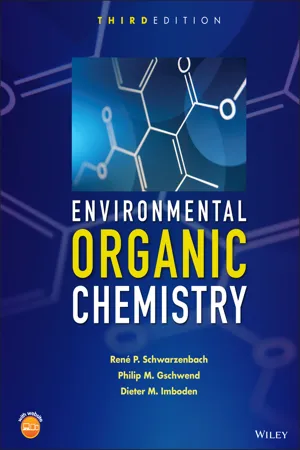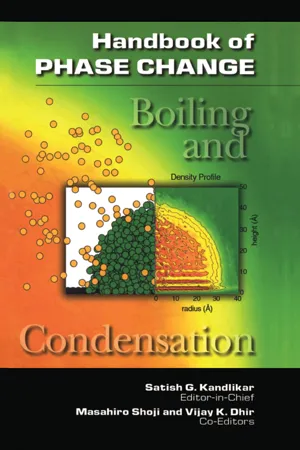Chemistry
Vapor Pressure
Vapor pressure is the pressure exerted by a vapor in thermodynamic equilibrium with its condensed phases, such as a liquid or a solid. It is a measure of a substance's tendency to evaporate and is influenced by temperature and intermolecular forces. As temperature increases, so does the vapor pressure, leading to increased evaporation.
Written by Perlego with AI-assistance
Related key terms
Related key terms
1 of 4
Related key terms
1 of 3
7 Key excerpts on "Vapor Pressure"
- eBook - ePub
- Joseph Angelo(Author)
- 2020(Publication Date)
- Facts On File(Publisher)
The term evaporation is also used. In the reverse process, called condensation, a substance in the gas (vapor) state becomes a liquid. When the evaporation rate of a liquid equals the condensation rate of the vapor, scientists say the liquid and vapor (gas) states of the particular substance are in equilibrium. They define the boiling point as the temperature, at a specified pressure, at which a substance in the liquid state experiences a change into the gas state. When a substance such as oxygen or nitrogen that is normally encountered as a gas on Earth experiences a change to the liquid state, scientists call the process liquefaction. Sometimes a solid substance is at a temperature and pressure that allows it to transition directly into the gas (vapor) state. Scientists call this process sublimation. A frozen block of carbon dioxide (CO 2) at room temperature and one atmosphere pressure will transition (sublime) directly into gaseous carbon dioxide. Scientists refer to the reverse process as deposition. Under certain environmental conditions, water vapor in Earth's atmosphere transitions directly into the familiar solid known as snow. Once formed, snowflakes gently deposit themselves on the planet's surface. Vapor Pressure is an important thermodynamic property of a liquid substance. Engineers regard it as a useful measure of a liquid's inclination to evaporate. Volatile substances are those with high Vapor Pressures at normal temperatures and pressures. Chemists use the term volatility to describe the tendency of a liquid to vaporize. Consider a sealed flask of liquid with a sufficient unfilled volume (space) above the liquid's free surface. Under equilibrium conditions, a number of molecules in the liquid will escape across the free surface and occupy the open space as gas molecules. Scientists define the Vapor Pressure of a liquid as the partial pressure of the vapor over the liquid under equilibrium conditions at a specified temperature - eBook - ePub
- Vladimir Danek †(Author)
- 2006(Publication Date)
- Elsevier Science(Publisher)
Chapter 7Vapor Pressure
Publisher Summary
This chapter discusses the thermodynamic principles and the measurement methods of Vapor Pressure. Vapor Pressure is an important part of investigation on molten salts. The mass spectroscopy method determines the composition of the gas phase and also determines the activities of components and the composition of both the liquid and vapor phases. Formation of vapor includes all the processes in which gas is created from a system of condensed phases. The measurement of Vapor Pressure is connected to the determination of equilibrium between the gaseous and liquid or solid phases. Pressure is one of the basic variables in thermodynamics. It is the force exerted by the system on the unit area of its wall. Two major experimental methods are used for the measurement of Vapor Pressure at high temperatures: the boiling point method and the transpiration method. Pressure equalization occurs very rapidly in the boiling point method, whereas thermal transport is rather slow. The transpiration method is a simple and versatile method for Vapor Pressure measurement at high temperatures. Hence, results from the transpiration method are also used to calculate the average molar mass of the vapor.The study of Vapor Pressure is an important part of investigation on molten salts. In connection with the mass spectroscopy method, which enables us to determine the composition of the gas phase, it is a useful tool to determine the activities of components and thus the composition of both the liquid and vapor phases.Formation of vapor includes all the processes in which gas is created from a system of condensed phases. Measurement of Vapor Pressure is closely connected to the determination of equilibrium between the gaseous and liquid or solid phases.7.1 THERMODYNAMIC PRINCIPLES
Pressure is one of the basic variables in thermodynamics. It is the force exerted by the system on the unit area of its wall. In the SI system, the basic unit of pressure is Pascal (Pa). One Pascal is equal to the force of one Newton exerted on one square meter, Pa = N · m−2 - Noel de Nevers(Author)
- 2012(Publication Date)
- Wiley(Publisher)
Chapter 5 Vapor Pressure, the Clapeyron Equation, and Single Pure Chemical Species Phase Equilibrium The Vapor Pressure is crucially important in a wide variety of physical and chemical equilibrium situations, such as those in Chapter 3. This short chapter discusses Vapor Pressure and related topics. 5.1 Measurement of Vapor Pressure The Vapor Pressure for a pure species is that pressure exerted by a pure sample of the liquid at a fixed temperature. The experimental procedure to measure Vapor Pressure is sketched in Figure 5.1. A sample of the material to be tested is placed in a closed container, with the amount chosen so that there will be both vapor and liquid present. Then the temperature is made constant over the whole container, normally by placing the whole container in a constant-temperature bath, with circulating water or some other heat transfer fluid. When the temperature and pressure readings have reached constant values, these are recorded, and the constant temperature bath is set for a new temperature. When the temperature and pressure readings are again unchanging, the values are again recorded, and a new temperature is chosen, continuing until the desired range of temperatures has been tested. Figure 5.1 Simplified schematic of the device for measuring the Vapor Pressure. Real vapor-pressure measuring devices are more refined versions of that shown in Figure 5.1, with special attention directed to getting very accurate measurements of the temperature and pressure, and to making sure that all the air and other possible contaminants are removed from the container, so that the sample being measured is as pure as possible. In principle, the measurement of the Vapor Pressure of solids is conducted exactly the same way as that of liquids; in practice, the pressure measurements are difficult because the pressures are very low- eBook - ePub
Chemical Property Estimation
Theory and Application
- Edward Baum(Author)
- 2018(Publication Date)
- CRC Press(Publisher)
CHAPTER 6 Vapor Pressure 6.1 INTRODUCTIONThis chapter describes methods of estimating the Vapor Pressure of a pure chemical and of chemicals in mixtures. The (saturation) Vapor Pressure, PS (Pa), is the pressure of a pure chemical vapor that is in equilibrium with the pure liquid or solid. It is an important control of a chemical’s partitioning between air, water, and soil and of its volatilization rate. For vapor-solid equilibrium, PS is sometimes called the sublimation pressure. The Vapor Pressure of a chemical in a mixture of volatile chemicals is its partial Vapor Pressure.Many different units of pressure are widely used in addition to the pascal, the SI unit. They include the standard atmosphere (1 atm= 101.325 kPa), the bar (1 bar = 100 kPa), the torr (1 atm = 760 torr), and the millimeter of mercury (1 mmHg ≈ 1 torr). The mmHg and the torr are almost exactly equal and can be used interchangeably.The reported saturation Vapor Pressures of chemicals at ordinary temperatures range from 760 to below 1 × 10−9 torr. Many hazardous chemicals exhibit Vapor Pressures of less than 1 torr in the normal ambient temperature range of −40 to +40°C. Vapor Pressures below 1 torr are difficult to measure, and reliable values are hard to find in the literature. Computational methods that offer reasonably accurate estimates of such low Vapor Pressures are particularly useful, therefore, and of particular interest to environmental specialists. The subject was reviewed by Burkhard et al. (1985) and Reid et al. (1987). The literature prior to 1981 was reviewed by Mackay et al. (1982) and by Grain (1990a).6.2 A Vapor Pressure MODELSaturation Vapor Pressure is a sensitive function of molecular structure and ambient temperature. Molecular structure determines the type and strength of the attractive intermolecular forces that a chemical exhibits. The attractive forces are, in order of increasing strength: the London dispersion forces exhibited by all molecules, polar interactions exhibited by all asymmetric molecules, and hydrogen bonding exhibited by molecules containing O–H, N–H, and F–H bonds. The energy required to escape the liquid phase and the Vapor Pressure depends on the sum of all forces exhibited by a chemical. - eBook - ePub
Principles of Chemical Engineering Processes
Material and Energy Balances, Second Edition
- Nayef Ghasem, Redhouane Henda(Authors)
- 2014(Publication Date)
- CRC Press(Publisher)
At a given temperature, the Vapor Pressure of a pure compound is the pressure at which vapor and liquid coexist at equilibrium. For a pure compound, there is only one Vapor Pressure at any temperature. In other words, Vapor Pressure is the pressure of the vapor when the vapor and liquid of a pure component are in equilibrium, also referred to as saturated pressure. Saturated temperature is the temperature at which the vapor and liquid coexist at a given pressure, commonly referred to as the boiling or condensation point There are four ways to estimate the Vapor Pressure when data are not available at a temperature of interest: the Clapeyron equation, the Clausius–Clapeyron equation, Cox chart, and the Antoine equation7.5.1 Clapeyron Equation
The Clapeyron equation gives a rigorous quantitative relationship between Vapor Pressure and temperature:where=dp *d TΔH ^vT()v g−v 1Δis the latent heat of vaporizationH ^vvg, v1 are the specific molar volume of gas and liquid, respectivelyT is the absolute temperatureAssuming ideal gas behavior of the vapor and neglecting the liquid volume, the Clapeyron equation can be simplified over a small temperature range to result in an expression known as the Clausius–Clapeyron equation7.5.2 Clausius–Clapeyron Equation
The Clausius–Clapeyron equation allows the calculation of the Vapor Pressure as a function of temperature. However, there are some additional parameters such as the heat of vaporization and the parameter B - eBook - ePub
- Rene P. Schwarzenbach, Philip M. Gschwend, Dieter M. Imboden(Authors)
- 2016(Publication Date)
- Wiley(Publisher)
rate of evaporation of a compound from its pure phase or a mixture.By simple observation, we know that at ambient temperatures (e.g., 25°C) and pressures (e.g., 1 bar), some organic chemicals in their pure form are present as gases, some as liquids, and others as solids. We should recall that when we talk about a pure chemical, we mean that only molecules of that particular compound are present in the phase considered. Hence, in a pure gas, the partial pressure of the compound is equal to the total pressure. As already addressed in Chapter 4 , a pure compound will be a liquid or a solid at ambient conditions if the forces between the molecules in the condensed phase are strong enough to overcome the tendency of the molecules to “fly” apart. In other words, if the enthalpy terms (which reflect the “glue” among the molecules in the liquid) outweigh the entropy terms (which are measures of “freedom” gained when going from the liquid phase to the gas phase), then the free energy term is positive, and the material will exist as a liquid or solid. Conversely, if this free energy term is negative, then the compound is a gas at the given conditions. This variation in phase is illustrated by the series of n-alkanes, where the C1 – to C4 –compounds are gases (p*i> 1 bar), the C5 – to C17 –compounds are liquids, and the compounds with more than 18 carbon atoms are solids at 25°C and 1 bar total pressure (Fig. 8.1 ) This series of hydrocarbons exhibits a Vapor Pressure range of more than fifteen orders of magnitude ranging from 40.7 bar or 4.07×106 Pa (C2 H6 ) down to about 10−14 bar or 10−9 Pa (n-C30 H62 - eBook - ePub
Handbook of Phase Change
Boiling and Condensation
- S. G. Kandlikar(Author)
- 2019(Publication Date)
- CRC Press(Publisher)
Figure 1 Pressure (P)-specific volume (v) diagram for a pure substance.Thus,d G⌋= 0T , P(1.1-1) 1.1.2 P-v-T RelationshipThe P-v-T relationship of a pure substance in thermodynamic equilibrium is usually indicated two-dimensionally on a P-v plane, on which isotherms are drawn as parameters. Figure 1 shows such a diagram with three isotherms. Since no liquid phase can exist above the critical temperature, Tc , the volume at constant supercritical temperature decreases with increasing pressure in a monotonic fashion. In the subcritical region below the critical temperature, isotherms show discontinuous change at the two-phase envelope, i.e., at the saturated liquid and vapor curves that meet together at the critical point C. To the left of the envelope is the region of subcooled liquid where the isotherm is nearly vertical, showing only a slight change of volume with large changes in pressure. To the right of the envelope is the superheated vapor region.The P-v-T relationship is also indicated on a P-T plane as shown in Figure 2 . This vapor-pressure curve terminating at the critical point separates the state of single phase into the subcooled liquid region to the left of the curve and the superheated vapor region to the right. Two-phase mixtures of liquid and vapor exist on the curve. In Figure 2 , the supercritical state is identified in the region where temperature and pressure are exceeding the respective critical values.1.1.3 Equation of StateThe functional relationship of P-v-T data is expressed by an equation of state. All gases and vapors behave like ideal gas in an extreme situation when pressure approaches zero and density becomes very low. In that case, their P-v-T relationship follows the ideal gas equation of state.Figure 2 Pressure (P)-temperature (T) diagram for a pure substance.P v = R T(1.1-2) Here, v is the volume per unit amount of the substance. The number of moles being taken as a measure to express the amount, then v is the molar volume. On the mass base, v
Index pages curate the most relevant extracts from our library of academic textbooks. They’ve been created using an in-house natural language model (NLM), each adding context and meaning to key research topics.
Explore more topic indexes
Explore more topic indexes
1 of 6
Explore more topic indexes
1 of 4
